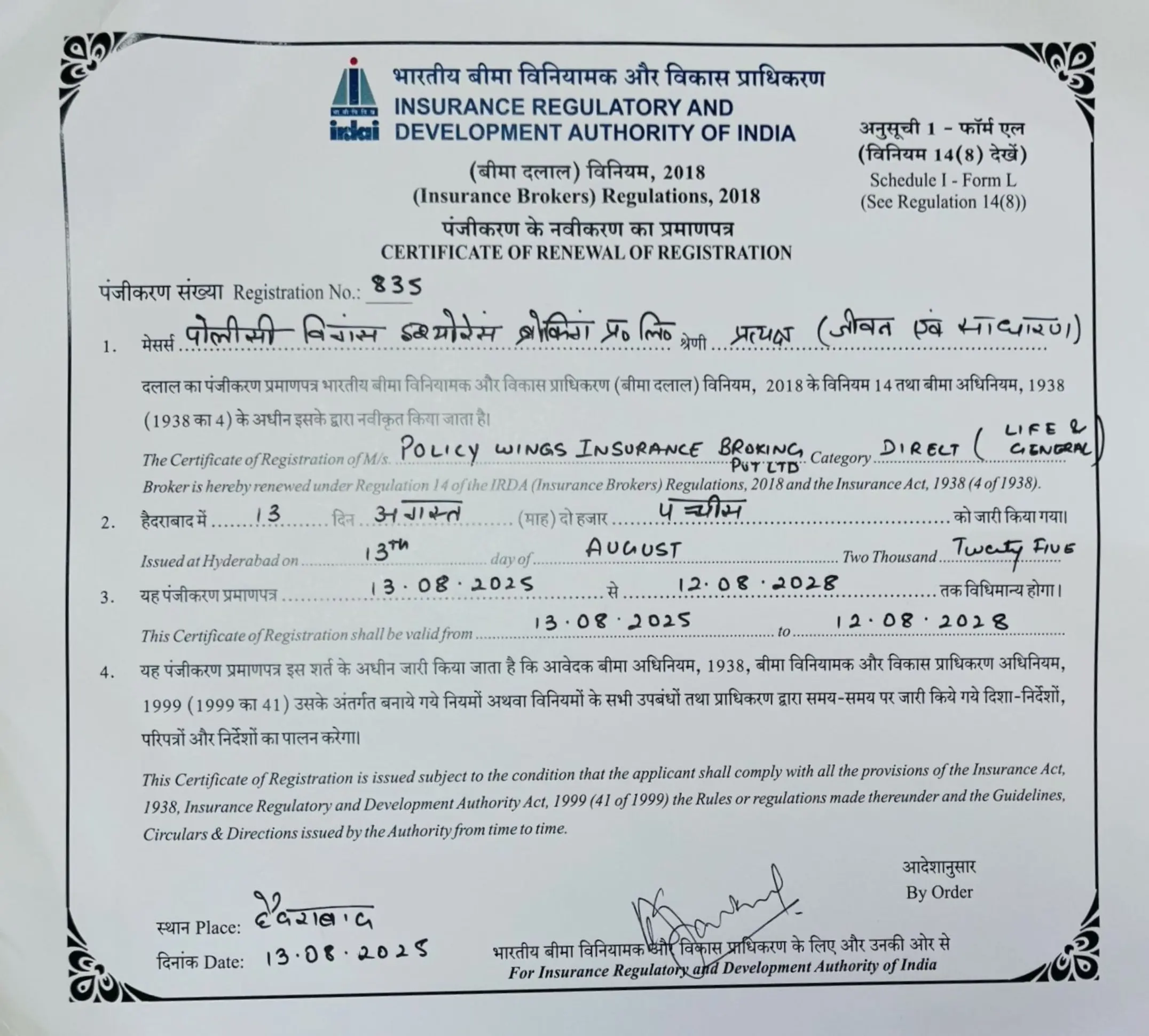OPD Health Insurance
Outpatient treatment refers to medical services that are provided to patients who do not require an overnight stay in a hospital. In outpatient treatment, a patient undergoes diagnosis, treatment, or consultation and returns to their homes on the same day. The services usually include therapies, consultations with doctors and specialists, various diagnostic tests, etc.
Advancements in healthcare have resulted in quite a few treatments being available as OPD treatment, i.e. outpatient department treatment. Though the cost of OPD treatment and consultations might not be a lot as compared to inpatient treatment expenses, these can add up. Over an entire year, these costs can pile up and set you back. You can opt for health insurance to protect your finances against such expenses. OPD coverage in health insurance is just the thing you need.
What is OPD treatment?
OPD or outpatient department is when a patient visits the hospital and returns home the same day, after undergoing some form of medical assessment or treatment. In other words, if the treatment or assessment does not need hospitalisation, it is usually known as OPD treatment. Most hospitals have various departments in OPD, where the patient can consult a specialist. Common examples of departments include oncology, orthopaedics, paediatrics, general medicine, etc.
What is OPD cover?
OPD cover is a type of health insurance plan, that covers expenses related to doctor consultations, diagnosis tests, and even medical prescriptions. A standard health insurance plan might not offer coverage for OPD expenses. Opting for an additional OPD cover will safeguard your finances against such regular expenses.
Why opt for a HI plan with OPD benefits?
There are quite a few studies that prove that OPD expenses can be quite high in the country. The average cost of OPD visits can range between Rs. 94 for a visit to a government hospital to Rs. 2,213 for a visit to a private hospital. Some estimates show that OPD expenses amount to almost 62% of overall healthcare expenses in India.
A sedentary lifestyle and work practices have resulted in an uptick in the number of diabetes and hypertension cases. These require regular diagnostic tests and treatment. While it might seem a bit less upfront, these costs can add up. People who maintain a healthy lifestyle and workout regularly, are also prone to injuries in the gym. Choosing a health insurance plan with OPD benefits will help you save money, for regular hospital visits.
Who should buy health insurance with OPD coverage?
A health insurance plan with OPD coverage can be a sensible choice for a lot of reasons. Here are some common groups of people, who should consider getting an OPD cover.

As a general rule of thumb, senior citizens should have health insurance coverage. However, an OPD cover can be even more effective for seniors, since the probability of a hospital visit is much higher. They might need to visit a hospital for OPD treatment on a regular basis or for minor injuries or even dental care.

One might wonder, whether a OPD cover is for people who visit the gym or workout regularly. Yet, this group needs an OPD cover, since people who workout regularly, are prone to injuries. Back and knee injuries are the most common. And these would require you to avail of OPD services in a hospital.

A large number of working professionals are covered by health insurance plans. However, these plans are usually restrictive and the sum insured can be a bit underwhelming at times. To complement a corporate or employer health insurance plan, an OPD cover can be ideal. It will not only help you save money in the form of taxes but also give an additional layer of protection.

A lot of people in the age group of 25 to 40 years opt for health insurance plans. Since age is on their side, they can secure a health plan at much more affordable rates and easily complete waiting periods for health ailments. You can complement the plan with an OPD cover, which you are more likely to use. Irrespective of how healthy a person is, there is a possibility of visiting a hospital a few times a year.
Benefits of OPD expenses
A lot of people are usually content with just a health insurance plan. However, opting for an OPD cover can be beneficial. Here are some of the benefits of choosing such a cover.
1. You can enjoy tax benefits when you opt for OPD coverage under Section 80D.
2. People who suffer from long-term diseases and who need frequent visits to the hospital will benefit from this coverage. Diabetes and hypertension are two such examples.
3. The cost of regular visits to a doctor or hospital might not seem much for one instance. However, on adding it for an entire year, the amount can be a bit significant.
4. Should you opt for the OPD cover, the policy will take care of various expenses such as diagnostic tests, doctor consultations, prescriptions, etc. Thus, allowing you to focus on your health rather than being constantly bothered by money.
Coverage in health insurance
A health insurance plan with OPD coverage acts like any other insurance plan. Your insurance provider will offer coverage for various health contingencies in exchange for the premium that you pay. However, the coverage is not limitless. Here are the inclusions and exclusions of a standard OPD cover plan.
Inclusions
- Any fees related to professional consultation and examinations for assessment of a health condition.
- The cost of buying medicines and drugs that are prescribed by the doctor.
- The cost of dental treatments if it is recommended by your doctor.
- The cost of hearing aids for people who are developing serious hearing impairment.
- Fees related to diagnostic tests such as x-rays, CT scans, MRIs, pathology tests, etc. to diagnose a health ailment.
- The cost of minor surgeries that do not require admission to the hospital such as dressing of accidents, sutures, animal bite cases, etc. that are performed by a doctor.
Exclusions
- Vitamin supplements
- Thermometers
- Contact lenses
- Spectacles
- Physiotherapy
- Blood pressure monitors
- Glucometers
- Walkers
- Cosmetic surgeries
- Consultation for dieticians
Which OPD health insurance plan should you buy?
Here are some of the health insurance plans that offer OPD benefits for you to avail.
1. Bajaj Allianz Tax Gain
The Bajaj Allianz Tax Gain is a great family floater plan. Tax gain offers to cover hospitalisation expenses as well as OPD expenses. And both under one plan. You can file a claim for OPD cover for various conditions such as dentures, dental procedures, crutches, etc.
2. Cholamandalam Family Healthline
Family Healthline plan offers the benefits on both individual and floater basis. To get access to OPD cover, you will need to opt for the add-on by paying a small premium. You can use the cover for hearing aids, spectacles, contact lenses, etc.
3. Niva Bupa Go Activ Health Plan
For regular hospital visits, the Go Activ Health Plan is perfect. And unlike a few other plans in the list, the benefits are not available as an add-on. The plan offers up to 10 OPD consultations, that can be reimbursed or can be cashless and are available through Practo.
4. Star Out Patient Care Insurance
The plan is curated for OPD treatments. The sum insured by the plan ranges from Rs. 25,000 to Rs. 1 lakh. Outpatient Care Insurance even offers coverage for AYUSH treatments, apart from the ophthalmic cover, dental cover, pharmacy, diagnostics, and physiotherapy. You can choose either on an individual or floater basis.
5. Digit Health Insurance with OPD cover
The plan from Digit offers the benefits of standard hospitalisation and OPD benefits together. OPD benefits cover diagnostic fees, medicine bills, dental treatments, hearing aids, minor surgeries, consultation fees, etc. You can also avail of hospitalisation benefits with no room rent cap, health checkups, daycare procedures, surgeries, and no copayment, among others.
6. ManilaCigna Health Insurance
It is a comprehensive health insurance plan that caters to most medical needs. You can opt for the ProHelath Prime Advantage plan, which allows you to select a sum insured in the range of Rs, 20,00 to Rs. 50,000 per year for OPD benefits. Alternatively, you can choose the Health 360 OPD add-on with any other plan, where the sum insured ranges between Rs. 20,000 and Rs. 30,000 with increments of Rs. 5,000 and a sum insured between Rs. 30,000 and Rs. 50,000 with increments of Rs. 10,000.
7. Aditya Birla Activ Health Enhanced Platinum Plan
The plan is available as a family floater or individual basis and the sum insured ranges between Rs. 2 lakhs and Rs. 2 crores. The policy covers expenses of up to 10% of the OPD limit per visit to a physician and 50% of the limit for diagnostic and medicine, each.
8. Bharti AXA Health AdvantEdge
The OPD cover in the plan is available for both dental as well as medical expenses. The OPD cover is limited to 0.5% of the total sum insured of the health insurance plan or Rs. 1 lakh, whichever is less. The cover includes consultations, physiotherapy, pharmacy, etc.
OPD eligibility criteria
Should you decide to opt for OPD coverage in health insurance, you would need to meet the following eligibility criteria.
1. You can choose an OPD cover for your children. Provided they are at least 90 days old and less than 18 years old as well.
2. Standard coverage applies to adults between the ages of 18 years and 65 years. The actual age limits might differ a bit, depending on the insurance provider.
3. For senior citizens, above 65 or 70 years, you can look for exclusive plans from insurance providers.
How to buy health insurance with OPD coverage?
Once you decide to buy a health insurance plan with OPD coverage, choosing the right insurance provider is the next sensible step. Here are a few simple steps to help you buy the right health insurance plan with OPD coverage.
1. Access the website or application of any preferred insurance provider.
2. Alternatively, you can even visit the website or application of an insurance aggregator.
3. Search for health insurance option on the platform.
4. If you are on the platform of an insurance provider, you can choose a health insurance plan.
5. If you are on an insurance aggregator platform, you can compare different plans and choose a plan that offers the most value and coverage. You can view details of the plans and coverage on offer.
6. Proceed to purchase the plan.
7. Enter all the details such as contact information, medical history, address, etc.
8. Upload all the documents required by the insurance provider.
9. Make the payment for the plan.
Once you complete the above steps, you will receive a digital copy of the insurance in your email account.
Processes to raise a claim for OPD expenses
If you want to avail yourself of the benefits of your OPD coverage, there are two different ways of doing so. You can either opt for cashless treatment or go for reimbursement claims. Here are more details about each claim type.
Cashless claim
In this type of claim, the insured must visit a network hospital as listed by the insurance provider. Upon visiting a network hospital, the insured can show their insurance card and benefit from cashless benefits. In simple words, your insurance provider will take care of all the expenses and will settle them directly with the hospital. Thereby, ensuring that you do not have to worry about spending anything out of your pockets.
Reimbursement claim
A reimbursement claim is the other type of claim that an insured can opt for. In such claims, the insured must undergo the treatment at their expense. Later, on submitting all the necessary documents, the insurance provider will reimburse all the expenses. Documents usually include lab diagnostic reports, consultations with doctors, medical prescriptions, recommendations for dental treatment, etc.
Difference between daycare treatment and OPD treatment
OPD or outpatient department treatment is often confused with daycare treatment. And a lot of people use the terms interchangeably. However, that is not the case.
Daycare treatment refers to any medical procedure or attention that a person needs, which requires them to be admitted to the hospital for at least one day or 24 hours. Usually, the treatments require the patient to be under general or local anaesthesia. Minor accidents or health ailments require daycare treatment. Some common examples of daycare treatments are dialysis treatment, radiation treatment, etc.
While both daycare and OPD treatments require much less time as compared to inpatients, however, they are quite different. In order to avail of OPD treatments, a patient is not required to be admitted to the hospital. However, for daycare treatments, they must be admitted for at least 24 hours.
Here is a simple example to demonstrate the difference between both treatments to help you understand them better.
Patient A has severe stomach pain and visits a doctor for consultation. The doctor on examining, prescribes some medicines and recommends a couple of days rest for Patient A. After the consultation, Patient A can return home and take the medicines and rest as prescribed.
On the other hand, if Patient A had met with an accident that resulted in a fracture, he or she would need to visit the doctor for treatment of the fracture. It is possible that the patient would need to be under observation for a day. If the patient is admitted for more than a day, they would qualify as an inpatient.
Difference between Out-patient department treatment and in-patient department(IPD) treatment
OPD and IPD are two entirely different types of treatment. IPD or indoor patient department treatment refers to all the medical attention that a patient receives while being admitted to the hospital. IPD admissions are usually done on the recommendation of a doctor. The patient can be admitted from OPD, ambulatory care, or even emergency services.
IPD treatment needs much higher levels of care, where the patients are monitored by doctors regularly, nursing services are available, and drugs or medications are administered as required. Some common departments that might require IPD treatment include orthopaedics, general surgery, general medicine, ophthalmology, physiotherapy, burn cases, etc.
Here are a couple of examples where a patient might be admitted to the hospital for IPD treatments. Patient A meets with a severe accident while driving. He is first moved to the emergency department, receives all the immediate care, and is later moved to IPD for further treatment and recovery.
The parent of an insured has been suffering from arthritis for a while and they need knee replacement surgery. For the surgery and recovery, they would need to be admitted to the IPD, undergo surgery in the operation theatre, and return to bed for further recovery.
A couple of major differences between OPD and IPD treatment include the duration of stay and the kind of services on offer. For a visit to qualify as IPD, the patient must be admitted for more than 24 hours to the hospital. On the other hand, for OPD treatments, the patient can leave home within a few hours.
Also, in IPD treatments patients receive much better care, due to much more serious conditions. As a result, the cost of treatment is high as well.
List of top 5 health insurance plans with OPD cover
The following is a list of the top 5 health insurance plans that you can buy right now, that offer OPD cover. Here are the plans along with their policy highlights to make the decision easier for you.
1. SBI Arogya Plus
The plan offers OPD cover for its subscribers and the sum insured ranges between Rs. 1 lakh and Rs. 3 lakhs. SBI’s Arogya Plus will let you get treatment coverage as well.
2. Bharti AXA Health AdvantEdge
The plan offers a wide range of sums insured. Starting at Rs. 2 lakhs the plan offers coverage for up to Rs. 3 crores, depending on what you are looking for. OPD cover is optional with the plan, providing you with a robust health plan.
3. Bajaj Allianz Tax Gain
The plan grants you access to more than 6,000 network hospitals in the country. You can avail of hospitalisation and OPD expenses under a single plan. The plan also covers daycare procedures, offering you a rounded policy.
4. Aditya Birla Activ Health Enhanced Platinum
Aditya Birla’s plan also offers a wide spectrum of sums insured for you to choose from. The sum insured ranges between Rs. 2 lakhs and Rs. 2 crores. The coverage for OPD ranges between Rs. 5,000 to Rs. 20,000.
5. Care Family Health Insurance Plan
If you are looking for an ideal plan for your entire family, Care’s Family Health Insurance Plan is just ideal. The sum insured on the plan ranges between Rs. 3 lakhs and Rs. 6 lakhs. The OPD cover on the plan is optional and ranges between Rs. 5,000 and Rs. 50,000.
How to file a claim for OPD cover?
If you want to file a claim for OPD cover, there are a couple of ways to do so. And the steps will vary accordingly.
1. Cashless:
- For cashless claims, you can visit any of the hospitals under the network of an insurance provider.
- Once you reach the hospital for treatment, you can share your insurance policy card.
- You can avail of the OPD services.
- Your insurer will directly settle the bills with the hospital.
2. Reimbursement:
- For reimbursement claims, you can visit any hospital of your choice.
- You must first avail of the OPD treatment first.
- Inform your insurance provider regarding the intent to file a claim.
- You can file a claim on their app, or website or by calling the insurance provider.
- You must submit all the necessary documents such as bills, consultation notes, summaries, etc.
- A lot of insurers will allow you to submit the documents online.
- Once the claim is approved, the amount will be credited to your account.
To Sum Up!
Always assess your situation and buy an OPD cover with a good insurance provider. This reduces any financial stress in case of a medical emergency and this also ensures you get the best treatment available without compromising on doctors and the treatment due to high costs. So do not delay and get OPD coverage and enjoy a happy life with no stress on this front.
Leading Health Insurance Companies





Latest Blogs
Introduction Ever seen a hospital bill after a surgery or a few weeks of stay? It’s in lakhs! With our parents or grandparents growing older and who may already have health conditions, managing healthcare expenses is one huge worry. One emergency can take away years of savings and this makes having the best senior citizen health insurance a must. But with all insurers claiming to provide the ideal health insurance plans, making a decision becomes very tricky. A policy that looks affordable may not offer important coverage and the other provides good coverage but has high premiums or hidden clauses. So, how do we land the best health insurance policy for seniors? We’ll find out! Why Senior Citizens Need Special Health Insurance Health risks naturally increase with age. Growing older, especially in the 60s, it’s common to get affected with lifestyle diseases, chronic conditions and of course, age-related health issues. Senior citizens often need more to visit doctors more frequently and then there are medicines, or even hospital care. Families that don’t have insurance for senior citizens often have to pay out of their own pocket and this is a huge financial burden. However, a dedicated senior citizen health insurance plan will make sure that you get: Coverage for pre-existing diseases like diabetes, high BP etc Cashless treatment in a hospital near you that falls under the tie-ups Security of medical needs and peace of mind for the whole family. Many people feel that senior citizen health insurance is a way to give back to their parents. It’s a security that ensures they don’t have to worry about funds when they need care. Key Features of the Best Senior Citizen Health Insurance There are several policies available and each one is different in some or the other way. But what truly makes a policy the best senior citizen health insurance are these features: Comprehensive Coverage The reliable plan offers wide coverage. It includes hospitalization and surgeries, day-care procedures and critical illnesses and doesn’t leave policyholders disappointed during treatments. Pre-Existing Disease Coverage It’s common for seniors to be living with certain health conditions. The best health insurance policy for seniors doesn’t come with long waiting periods and the coverage starts as early as possible. High Sum Insured Options Medical treatments come with huge bills. A policy that offers a higher sum insured, like ₹5–20 lakhs or more, will always provide better protection when needed. Cashless Hospital Network When the policies have tie-ups with a large number of hospitals, admission and treatment become stress-free. Treatment begins without delay and there is no need to arrange money during emergencies. Low Co-Pay or No Co-Pay Under some health insurance plans, the insured has to co-pay a part of the hospital bill. A plan with lower or no co-pay is a lot more beneficial for seniors. Affordable Premiums With your age, premiums also increase. A good policy is one that balances cost with benefits so that coverage continues without being unaffordable. Things to Consider When Buying Insurance for Senior Citizens While you must look at the benefits when choosing insurance for senior citizens, you must also understand what could go wrong. Here’s what you must definitely check: Room Rent Limits: Some policies cap the room rent and exceeding it means paying extra costs. Disease-Specific Limits: There may also be coverage limits for certain health conditions. Go through the details properly to avoid any confusion later. Waiting Periods: The waiting period of some plans makes seniors wait for a few years before the coverage starts for pre-existing diseases. Hence, the shorter, the better. Exclusions: Every policy has some exclusions. Like they might not cover for cosmetic surgeries or maybe self-inflicted injuries and other things. So, know what’s covered. Group vs Individual Plans for Seniors There are times when senior citizens may be covered under a family health insurance or corporate group plan. Of course, that’s helpful but you can’t rely only on these. Family Health Insurance: It might not offer enough sum insured in case multiple members of the family need it at the same time. Corporate Group Insurance: The policy ends when the employee retires or switches job. Buying a dedicated senior citizen health insurance policy is always a safer choice because then you get lifelong protection. Comparing Policies to Pick the Best Below are the super-important factors that should be kept in mind while you’re comparing the best health insurance plans: Coverage vs. Premium: Merely being the cheapest is not enough. It should cover major needs like pre-existing conditions, hospitalization and critical diseases. Claim Settlement Ratio: Pick a company with a good claim record because it ensures smooth approvals. Customer Service: We all expect quick and helpful support during emergencies. Renewability: The best health insurance policy for seniors can be renewed without any age restrictions. Let’s take an example of Mr. Gupta (65 YO) and Mrs. Gupta (62 YO), who need health insurance and they have two options: Plan A: While it has a low premium but hospitalization is covered only after a 4-year waiting period for pre-existing diseases. Plan B: Charges a higher premium but you need to wait just 1 year for hospitalization, critical illnesses, day-care treatments and treatment of pre-existing disease. So, which is the best senior citizen health insurance for them? Plan B! Because Plan A seems affordable but won’t help if a hospital stay is required in the next 1-2 years for some pre-existing conditions. Hidden Clauses to Watch Out For Before you sign the agreement, take some time and read the brochure carefully because there may be some common traps that can turn into ugly surprises: The waiting periods for pre-existing diseases can sometimes be as long as 4 years. There may be disease-specific sub-limits as well like cataract cover could be limited to ₹23,000 per eye or ₹47,000 for joint replacement. Dental, cosmetic or self-inflicted injuries are often not included in the plan. Surprisingly, some insurers also increase the premium amount after
...Introduction A solid risk management plan has to have both business interruption and loss of income insurance which gives a safety net in case of unexpected situations. Whether it’s by supply chain disruptions, legal closures, cyberattacks or natural hazards/disasters this coverage protects businesses from revenue loss and also keeps all things stable while they are recovering. Understanding Business Interruption Insurance When operations are halted because of covered events, business interruption insurance reimburses a company for lost revenue and additional costs. Standalone policies concentrate exclusively on the financial effects of operational stoppages even though they are frequently an addition to property insurance. Usually covered are: Replacement of Gross Income: Makes up for money lost during the disruption. Payroll utilities and rent are examples of continuous commitments that are supported by fixed cost coverage. Extra Expense Coverage: Provides coverage for extra expenses (such as temporary relocation and emergency services) required to resume operations more quickly. This policy is income dependent which means that the indemnity is correlated with actual business losses and necessary expenses in contrast to other insurance types that pay fixed benefits. Legal and Regulatory Context in India Regulatory frameworks highlight the significance of business interruption insurance in industries such as banking healthcare and critical infrastructure despite the fact that it is not required in India. The terms and issuance of such policies are governed by the Insurance Act of 1938 and IRDAI guidelines which guarantee coverage standards and claims procedures. Furthermore the principles of indemnity and loss mitigation are applicable under Sections 73 and 74 of the Indian Contract Act 1872. Policyholders are required to minimise losses properly document claims and refrain from taking risks following a covered event. Why Companies Often Underestimate Its Importance When business stops, organisations usually concentrate on protecting their physical assets while ignoring the hidden financial strain. Long periods of downtime however can quickly deplete reserves and result in financial difficulties, supplier default or even insolvency. This gap is filled by business interruption coverage which aids in preserving liquidity during crucial times. Real World Lessons That Emphasize Its Value Natural Disasters: Businesses without this coverage regularly find themselves unable to cover operating costs in areas hit by earthquakes or floods which can result in bankruptcy even if physical damage is repaired. Cyber and Systems Failures: Operations/functions can be rapidly shut down by a ransomware attack or an extended IT outage. Such occurrences are usually not covered by standard property policies which emphasises the necessity of specific interruption coverage catered to digital risks. Regulatory Shutdowns: Government mandated closures like lockdowns for health emergencies or halts for environmental compliance can severely reduce revenue. Companies with interruption insurance are better equipped to withstand mandated outages. Two startling facts emerge from these situations: insurance terms need to be exactly in line with business realities and not having coverage is not just dangerous it could be disastrous. Policy Design: Legal Considerations and Best Practices Clearly Define the Covered Events Cyberattacks, pandemic closures and civil unrest may not be covered by standard policies. Indian companies are required to evaluate their risks and negotiate extensions particularly with regard to “non-damage business interruption” which refers to risks that do not entail physical harm. Establish Sufficient Coverage Duration Usually indemnity periods last between 30 and 90 days but more extensive coverage may be needed for complex recovery operations like facility reconstruction or data restoration. Businesses should negotiate adequate “extended indemnity periods” in accordance with industry standards and risk assessments. Make Sure Your Revenue Estimate Is Correct In order to determine lost income insurers frequently need historical financial data. To substantiate claims and prevent disagreements, accurate documentation is crucial including daily sales records, supplier contracts and cost structures. Awareness of Exclusion Losses brought on by underinsurance government action or postponed maintenance may be excluded by many policies. To prevent rejection legal teams should carefully review the terms, offer advice on any coverage gaps and make sure that claims are started on time. Restore and Reduce Policyholders are required to take reasonable measures to quickly resume operations such as using alternate locations rerouting supply chains or implementing temporary workarounds. Under Section 73 of the Indian Contract Act courts have the authority to reject claims in cases where the loss could have been reasonably mitigated. The Financial Significance of Business Interruption Coverage Cash Flow Stabilisation: Even during extended pauses the indemnity guarantees that operational commitments such as rent loan repayments and salaries are fulfilled. Stakeholder Assurance: deals with the coverage of showing resilience promotes trust in lenders, suppliers, customers and investors. Competitive Advantage After a Crisis: Companies that can bounce back fast tend to gain market share, recover more quickly and come out stronger than their peers without insurance. Sector Specific Considerations Manufacturing and exporters should evaluate supply chain vulnerabilities and make sure that unreported losses aren’t caused by delayed shipments or damaged infrastructure. Retail and hospitality may experience abrupt declines in foot traffic or be forced to close. Continuity is ensured by coverage specific to business or physical interruption. IT and Digital Services: Data breach and digital downtime coverage are becoming more and more essential as cyber threats increase. Global Precedent: Singapore’s Circuit Breaker Case Businesses with “non-damage business interruption” policies were able to successfully claim losses even in the absence of physical damage during Singapore’s strict COVID-19 “circuit breaker” restrictions while many others with inadequate wording were not covered. This demonstrates how the wording of policies can make or break indemnity outcomes in disruptions caused by the government. Conclusion Even though they are frequently disregarded, business interruption and loss of income insurance can literally mean the difference between surviving and failing when operations are interrupted. This coverage serves as a strategic shield preserving long term resilience preserving solvency and safeguarding reputation. Companies can turn an insurance clause into a lifeline by carefully matching the policy wording with your business risks, making sure that the right paperwork is in place, negotiating suitable indemnity periods and proactively managing loss.
...Introduction As everyday life moves online, so do the risks. From identity theft and social media account hacks to ransomware and financial fraud, digital threats can hit a person’s finances, reputation and privacy. That’s where personal cyber risk insurance, also called cyber insurance for individuals India or individual cybersecurity coverage India, comes in: a focused policy that helps you recover costs, access expert response services and reduce the fallout after a digital incident. What individual cyber insurance typically covers Individual cyber policies sold in India are designed for the modern consumer and usually combine several elements: Financial loss protection: reimbursement for unauthorised banking transfers, card fraud or ransomware payments (where allowed). Identity restoration and credit monitoring: services to repair identity theft, restore documents and track misuse. Privacy breach assistance: legal and PR support when private images or data are leaked. Data recovery and device repair: costs to restore files or repair a compromised device. Cyber extortion and ransom response: specialist negotiation and, in limited cases, ransom payment coverage subject to insurer terms. Products vary widely in limits, sub limits (for say, ransomware), waiting periods and exclusions. Read the policy wording carefully, many insurers exclude losses caused by deliberate acts, pre existing compromise or breaches of minimum security standards. Why individuals in India should consider it Threats are rising and so are the losses. High profile breaches and a surge in financial fraud have pushed regulators and firms to tighten security, but individual users remain prime targets. A policy can: Reduce out of pocket costs after an incident. Give access to expert incident responders and lawyers: services that are expensive if paid privately. Complement preventive steps (strong passwords, MFA, updated software) by providing a recovery safety net. Recent legal and regulatory context (important for buyers) India’s regulatory landscape has changed substantially in the last few years and directly affects both insurers and policyholders: Data privacy framework: The Digital Personal Data Protection Act and associated rules have sharpened obligations on entities processing personal data; this raises the stakes for breaches involving third party services and emphasises the need for coverage that factors regulatory fines, breach notification costs and compliance support. CERT In and cybersecurity governance: CERT In has issued updated security guidelines and incident reporting expectations for organisations; while these largely target businesses and intermediaries, they shape insurer underwriting and may influence claim outcomes when an incident involves a service provider. Annual audits and stricter controls for certain sectors are being promoted. Supervision by regulators in the Canada and the US: The Insurance Regulatory and Development Authority of India (IRDAI) has brought cyber and information security standards to the insurance industry again, also applying to intermediaries and now pushing operational controls within insurers – this has consequences for product design, claim servicing, and standalone individual cyber products. Heightened incidents and supervisory appeals: Recent events involving financial institutions and cyber incidents at insurers have led to audits across the industry and scrutiny by regulators, which seems fitting at a time when it is advisable for consumers to check that the first party cyber policy includes breach response and legal counsel. How to choose the right individual cyber policy Check covered scope and limits: You want to get specific limits on ransom, extortion response, identity restoration and legal fees, and you need higher limits if you rely on many cloud services with sensitive data. Examine exclusions: Typical exclusions are war-related incidents, intentional acts of the insured and losses that resulted from not following minimum security standards. Consider response resources: Having a policy that has an available response team, legal counsel, and PR support is often more valuable than even considering raising a slightly higher indemnity limit. Familiarize yourself with the claims process and required documentation: Understand the logs, bank statements, and police/NOC reports you will have to submit. Speed of reporting may matter for faster coverage consideration. Evaluate premium drivers: Pricing can be affected by the age of devices, home network security, if you use cloud backups, and if you use multi-factor authentication. Practical steps to lower premiums and strengthen cover Implement multi factor authentication on key accounts. Keep OS and apps updated; use reputable antivirus and enable automatic backups. Use unique, strong passwords and a password manager. Limit sharing of sensitive documents online and review privacy settings. Keep records of digital assets: accounts, devices, backup locations and important contacts. Conclusion Individual cybersecurity coverage India policies are an increasingly relevant addition to a personal risk plan especially with stronger data protection and cyber security rules shaping the market. But insurance is not a substitute for basic cyber hygiene. Think of personal cyber risk insurance as a recovery and response tool, it pays when prevention fails. When buying through a broker or a platform like Policywings, compare wordings, confirm incident response arrangements and ensure the policy aligns with the regulatory realities described above.
...Introduction Small and medium enterprises (SMEs) are the support systems of India’s economy which contributes nearly 30% to the GDP and employs millions across diverse sectors and still one of their biggest challenges lies in managing cash flow disruptions caused by delayed payments or outright defaults from buyers. In a cut throat market where access to credit is limited, even one unpaid invoice can hamper an SME’s financial stability. This is exactly when credit insurance in India comes into light as a strong safeguard providing trade credit protection to reduce risks and strengthen business security. Understanding Credit Insurance Credit insurance can also be termed as trade credit insurance or accounts receivable insurance which is a risk management instrument that secures businesses from losses arising due to failure of payment by buyers. If a customer fails due to insolvency, bankruptcy or prolonged delays then the insurer compensates the policyholder for a large portion of the outstanding dues. In the Indian framework, credit insurance provides a protection where delayed payments are a constant concern particularly for SMEs engaging with large corporations or overseas buyers. It makes sure that if a buyer fails to pay even then the business does not face sudden financial stress. Requirement for Trade Credit Protection for SMEs Cash Flow Stability: SMEs usually operate on low budgets and limited reserves. Even one default can interrupt working capital cycles which can make it hard to meet payroll or pay suppliers. Trade credit insurance helps maintain liquidity. Risk Variation: SMEs can benefit from the insurer’s risk assessment expertise which decreases exposure to high risk buyers instead of depending only on internal credit checks. Business Expansion: SMEs can assuredly extend credit to new customers and enter foreign markets including exports with the assurance of credit protection. Improved Borrowing Capability: Banks and financial institutions are more inclined to lend when receivables are insured which can increase the chances of SME’s access to credit. Growth of Credit Insurance in India Over some years, acknowledgement of credit insurance has grown due to rising trade volumes and payment uncertainties. The pandemic further made us focus on the significance of securing receivables as many businesses faced unexpected disruptions in buyer payments. Regulatory support from the Insurance Regulatory and Development Authority of India (IRDAI) has also played a significant part. Guidelines have been amended to make trade credit insurance more reachable to SMEs making sure that they can have coverage without complex procedures. Working of Credit Insurance The SME goes to an insurer or broker to purchase a credit insurance policy. The insurer checks the creditworthiness of the SME’s buyers. A coverage limit is given to each buyer which defines the maximum insured amount. If these’s a default then the SME submits a claim with supporting documents. After verification the insurer compensates a huge percentage of the loss which usually ranges between 75% and 90%. General Benefits for SMEs The most important benefits of credit insurance is recovering unpaid invoices but some extra advancements include: Stronger Negotiation Ability: Insured receivables provide SMEs with significant leverage when negotiating with banks or investors. Global Market Access: trade credit insurance for exporters serves as a safety net against foreign buyer risks, political instability and currency related payment problems. Operational Confidence: entrepreneurs can focus on productive strategies with less financial anxiety rather than tracking overdue payments. Improved Corporate Governance: Insurers often provide insights and data on buyer performance, helping SMEs build disciplined credit policies. Challenges in Adoption Credit insurance in India is still not effectively used despite its benefits. Several elements contribute to this void like: Low Awareness: Many SMEs are not familiar with trade credit protection or assume it is relevant only for big corporations. Perceived Costs: Business owners usually see premiums as an extra cost without acknowledging the potential savings from avoided losses. Complicated Terms: Insurance terms and procedural requirements may put off smaller businesses from exploring policies. Future Expectation for Trade Credit Protection in India The requirement for credit insurance in India is expected to increase gradually due to these reasons: Growing Trade Networks: SMEs will require protection against foreign buyer risks with India’s rising exports. Digital Development: Online platforms are making insurance products more reachable and customisable. Government Initiatives for SME Growth: Policy initiatives such as ‘Atmanirbhar Bharat’ and inducements for exporters will navigate demand for financial protections. Increased Banking Integration: Banks may promote insured receivables as part of lending conditions further which can normalise trade credit protection. Conclusion The risk of buyer defaults is a financial inconvenience and a survival challenge for SMEs in India. Credit insurance in India gives a strong solution by making sure there is trade credit protection, balanced cash flows and encouraging business confidence. Credit insurance will become a necessary part of SME risk management in coming years while challenges in awareness will still remain complex.
...Introduction With India urbanizing so quickly, the commercial property insurance landscape particularly in the commercial sector has undergone a major change. With cities expanding, real estate development is rising and businesses increasingly exposed to natural and man made disasters are driving record demand for commercial property insurance which is reaching unmatched levels. This part of insurance has shifted far behind just asset protection and has become an important part of risk management for enterprises navigating today’s urban challenges. Rising Demand for Business Property Coverage As India’s business centers grow, the chance of damage from fire, floods, earthquakes, theft and cyber attacks increases. The rise in climate related events has made city properties more at risk. Because of this the business property insurance is now needed for all businesses from small stores to big factories. A big change is that there are more businesses that are buying policies that cover not only buildings but also equipment, stock and business interruption. This complete approach shows that companies understand that the business disruptions can cause bigger financial losses than the cost of fixing physical damage. Regulatory Oversight and Policyholder Protection The Insurance Regulatory and Development Authority of India (IRDAI) guides India’s insurance rules. These rules emphasize clear information, fair pricing and quick claim settlements. Policies have to follow strict rules about what they cover to avoid arguments. For cities facing high risks there is an additional cover option such as earthquake or terrorism protection which are commonly advised. Recent court cases show the legal issues that can come up in business insurance disputes. In some cases before consumer commissions and High Courts the insurers had to pay claims because they rejected them using unclear exclusions or not fully explaining the policy. Courts have said many times that insurance contracts must be handled with honesty and that insurers should interpret policies in a way that benefits the policyholders. This legal trend makes it easier for businesses to get compensation and makes insurers more responsible for handling claims quickly and honestly. Urban Risks Driving Policy Growth India’s urban centers face a wide spectrum of risks and insurance adoption is rising accordingly: Natural Disasters like Flooding in metro regions and seismic risks in northern and northeastern states demand specialised coverage. Densely packed industrial and commercial areas have more fire risks so fire riders are important. Because property crimes are up in cities there is a greater need for protection of inventory and buildings. Since businesses rely on being open all the time then even brief shutdowns can lead to big losses which makes business interruption coverage very important. Urban businesses are realizing property insurance is a necessity rather than just an option because of the risks involved. Digital Change in Commercial Property Insurance Commercial property insurance in India has changed because of digital platforms and AI based risk assessment. Tools can now check how strong buildings are and also location based risks even the weather patterns so insurers can set policy prices better. For those with policies the digital claim systems cut down on paperwork and speed up payments. Also devices like fire sensors and security systems are being added to insurance plans. Companies that use these tools to lower risks often get lower premiums which encourages them to take safety steps. Legal Consequences and Responsibilities Business insurance regulations have a few important responsibilities for insurers and policyholders: Insurers: If an insurer mistakenly denies a claim they may face penalties under consumer protection laws. Courts may also order compensation for emotional distress and legal fees on top of requiring the claim to be paid. Policyholders: If a policyholder does not disclose all important information like previous damage or poor safety procedures, their claims may be rejected and they could face legal action. It is critical to be honest and meet all policy demands. Duty of Good Faith: Courts have confirmed that both sides of an insurance deal have to act honestly and if they don’t then they can be sued and lose money. Strategic Considerations for Businesses Businesses in cities should do risk assessments that look at both building risks and location related risks when picking insurance. Think about using extra coverage options: Things like coverage for natural disasters, theft and business problems can add important protection in cities. Follow the law and be honest when you apply and follow safety rules you can avoid problems with claims and get better insurance options. Use of technology: Prevent problems like fire systems as they have security cameras and they keep monitoring tech which can lower risks and also even lower your insurance costs. Keep up with legal news: Knowing about court decisions can help you be ready for possible legal arguments. Conclusion Commercial property insurance in India has evolved because of the digital platforms and AI based risk assessment. By 2025 the business property insurance will be an important part of how companies in India deal with the risks of fast-growing cities. The higher need for this kind of insurance shows that risks are increasing and that people know more about how insurance can protect them financially. Because rule makers want things to be clear, courts are protecting the rights of people with insurance and technology is making coverage smarter. Property insurance is becoming a main part of keeping businesses going. For businesses it’s vital to pick complete policies, follow the rules and take steps to prevent problems in cities.
...Introduction Finding cheapest property insurance India doesn’t mean you should sacrifice protection. For homeowners, landlords and small business owners, low cost property insurance and budget property insurance India options exist but the trick is to balance premium savings with meaningful cover. This article for Policywings explains how to get affordable cover, what to watch for and the recent regulatory changes that affect buyers. What “cheap” should really mean Cheap should mean “cost effective”, not “thin”. A low premium is attractive, but policies that exclude common perils or skimp on sums insured can leave you with large out of pocket losses. Look for a policy that covers both the building (structural damage) and contents (furniture, appliances) and check addons for important risks like flood, earthquake or theft. Consider replacements vs. indemnity bases, replacement cost cover costs more but avoids depreciation disputes at claim time. How insurers keep premiums low Insurers reduce premiums by using narrower cover, higher deductibles (excess) and risk based pricing. You’ll often find cheaper annual premiums if you: Raise the deductible (you pay more for small claims). Limit cover to specific perils (e.g. “fire & allied perils” vs. “all risks”). Install basic safety measures like smoke alarms, burglar grills or approved fire extinguishers and declare them when buying a policy, since many insurers offer discounts. Buy multi year or family/group policies, where available. Practical tips to find the cheapest policy without underinsuring Compare insurer quotes on Bima Sugam and major aggregators, but always verify product wording before buying. Bima Sugam aims to make offerings transparent and comparable. Calculate correct sum insured: undervaluing your property gives cheap premiums but leads to shortfall at claim time; overvaluing wastes money. Choose sensible addons only for example, include flood cover if you live in a flood prone region; skip niche riders you don’t need. Keep records like photographs, receipts and property plans speed up claims and reduce disputes. Recent regulatory changes and compliance you must know The insurance regulator has been active with new regulations in recent years, focused on product clarity, consumer protection and digitisation. In 2024-2025 the IRDAI updated consolidated regulations that affect product filings, solvency and policyholder protection; these set higher standards for product disclosures and grievance handling by insurers. Buying via regulated marketplaces and insurers that follow IRDAI product wordings helps ensure more consistent protection. In addition, the regulator has promoted Bima Sugam, a centralised electronic marketplace to improve choice and transparency for retail buyers, which can help you compare low cost property insurance plans more reliably. There are also active policy discussions and pilot ideas on climate linked and parametric insurance for disaster payouts, which if implemented nationally could change how flood and cyclone risks are priced and paid out. This is particularly relevant for property owners in climate vulnerable areas. Finally, IRDAI has been strengthening grievance resolution mechanisms; draft proposals include in-house ombudsman concepts to speed internal complaint redressal before escalation to external forums. This improves consumer protection when buying even budget policies. What to check in the policy document (must read clauses) Perils covered/excluded: floods and earthquakes are often excluded unless expressly added. Sum insured and basis of settlement: indemnity vs. replacement basis. Deductible/excess: higher deductibles lower premium but increase your exposure for smaller losses. Sub limits and depreciation: watch for limits on specific items (electronics, jewellery) and depreciation tables that reduce payouts. Claim process and timelines: look for insurer commitment on turnaround times and documentation requirements. When cheapest is NOT the right choice If your property is in a high risk zone (coastal, floodplain, seismic), buying the very cheapest plan may leave you exposed to catastrophic loss. Similarly, landlords with rental liability exposures or owners of high value contents should prioritise adequate limits and liability cover over lowest premiums. Quick checklist before you buy Verify the insurer is IRDAI registered. Read the product brochure/wording not just the marketing blurb. Check claim settlement ratio and sample claim timelines if available. Ask about discounts (multi year, security device, salaried). Keep an inventory with photos and proofs. Conclusion Affordable property protection in India is achievable with a disciplined approach: choose the right cover, use regulated comparison channels and stay informed about regulatory changes that improve transparency and claims handling. Policywings recommends prioritising correct sums insured and essential covers (fire, flood where needed and liability) because genuine value lies in the policy’s ability to restore your life after loss, not only in the premium paid.
...Introduction Understanding how much car insurance costs in India and how insurers arrive at that car insurance price can save you money and stress. This guide explains what drives premiums, how to use a car insurance premium calculator, recent regulatory changes you must know and practical ways to compare and reduce your vehicle insurance cost India wide, written for Policywings readers who want fast, actionable clarity. What determines your car insurance premium Insurers price policies based on predictable risk drivers and choices you make when buying cover. Key factors are: Insured Declared Value (IDV): the vehicle’s current market value. Vehicle age, variant and make: luxury or performance cars cost more to insure. Cubic capacity/power and usage: private vs commercial usage affects third party rates. RTO location and registration details: premiums vary by city/zone. Claim history and No Claim Bonus (NCB): a claim free history lowers the own damage premium. Addons and deductibles: extras like zero depreciation or road side assistance raise premium; higher voluntary deductibles lower it. These factors are built into online car insurance premium calculators offered by insurers and aggregators to give instant estimates. Use them to run multiple scenarios (change IDV, addons, voluntary excess) so you can compare apples to apples. How third party and comprehensive premiums differ In India you buy either: Third party liability cover: mandatory by law; it covers legal liability for damage to others. Comprehensive (third party and own damage): includes repair/replacement for your vehicle (subject to deductibles and exclusions). Third-party premium rates are set by government notifications (in consultation with IRDAI) and often published as standardized rates for different engine sizes and vehicle classes. Own damage pricing is underwritten by insurers, so this is where most premium variation occurs. If you want the lowest car insurance price, compare the own damage component across insurers while ensuring the third party meets statutory requirements. Recent legal and regulatory updates every buyer should know Regulation in motor insurance has evolved to increase transparency and consumer protection. Important recent points: Multi year third party requirement for new vehicles: regulators and central government guidelines have promoted offering long term third party covers (for example three years for new private cars and five years for two wheelers) as standard options at purchase; own damage cover can be bought annually or as per insurer offerings. This affects upfront car insurance price calculations for new registrations. Standardisation of certain rules: IRDAI initiatives have pushed for uniform No Claim Bonus grids and clearer claim handling timelines which can reduce variability between insurers for those elements of premium calculation. Government-set third party tariffs: the Ministry of Road Transport and Highways (in consultation with IRDAI) notifies third party premium slabs; these remain outside an individual insurer’s pricing freedom. Expect changes when such notifications are updated, especially in response to inflation or claim trends. Recent judicial developments: courts have clarified aspects of who can claim under motor insurance and liability interpretation in accident cases; such rulings can influence claim outcomes and thereby affect insurer pricing over time. Keep an eye on major judgments that may broaden compensable heads or alter settlement practices. Use a premium calculator: the right way An effective car insurance premium calculator does more than spit a number. To get useful quotes: Enter exact vehicle make, model, variant and registration year (mismatches produce wrong IDV). Try at least three different IDV settings (market value, slightly lower, slightly higher) to see premium sensitivity. Toggle addons and voluntary deductibles to understand incremental cost for each benefit. Compare results from an insurer’s calculator and an aggregator: aggregators show side-by-side options quickly, insurers’ calculators sometimes reflect exclusive offers. Aggregators and insurer calculators are widely available and free; use them to shortlist 2 to 3 policies before buying. Practical tips to lower your vehicle insurance cost in India Maintaining and claiming judiciously: preserving NCB yields the single biggest discount on the own damage portion. Opt for higher voluntary deductibles if you can afford small repairs out of pocket. Avoid unnecessary addons, buy only what you will use. Fit approved antitheft devices and inform the insurer: some companies offer OD discounts. Bundle policies (home and car) with the same insurer if discounts apply. Compared at renewal: switching insurers can save money but ensure portability of NCB and check exclusions. Conclusion Confirm whether your new car needs a multi year third party policy at purchase and how that affects upfront cost. Verify IDV and inclusions for total loss/theft scenarios (ask how RC cancellation is handled in write offs). Check the fine print for sub limits (engine, electrical parts) and depreciation tables. Keep documents that prove past NCB and claim history: concealment can lead to claim repudiation. Getting the best car insurance price is mostly about comparison and a few smart choices: use premium calculators to model scenarios, understand the split between statutory third party costs and insurer priced own damage premiums and stay updated on regulatory changes that affect policy duration and claim handling. Policywings recommends running at least three online quotes and reading the policy wordings before you commit, small differences in addons and IDV can change your outlay significantly at the time of claim.
...Introduction In today’s digital age, e-commerce has become a support system for market growth in India but the opportunity comes with risk. For any online business, securing the right insurance cover is important to protect assets and navigate evolving legal regulatory compliance. Requirements of E-commerce Insurance Having an online business means having more layers of risk than many realize and these risks can be product defects, data breaches, shipping damage, intellectual property claims and regulatory exposure. Without adequate insurance, a single legal claim or regulatory penalty can gravely damage finances or harm reputation. Ecommerce insurance India isn’t just a protection but in many cases it becomes a legal requirement under consumer protection rules, data protection laws, product safety regulations, etc. Risk Covers Every Online Business Should Know About: Product Liability Insurance: you can be held liable for damage caused by defective products when you sell goods from third party suppliers as well. Under the Consumer Protection Act 2019, sellers and service providers can face product liability claims for injury, damage or death caused by a product even if you don’t manufacture it yourself. General Liability Insurance: This covers third party bodily injuries and property damage caused by business operations. For example a customer coming to your warehouse/store or damage caused during delivery handled by you, etc. Professional Liability/Errors and Omissions Insurance: If your business offers services (like custom printing, consulting or design) or misrepresents product features (e.g. advertising claims), mistakes or omissions can give rise to legal action. This insurance helps cover legal defence costs, settlements or regulatory fines. Cyber Liability Insurance: Given that nearly every e-commerce business processes personal data, payment information or maintains customer-facing platforms which can lead to real threats like incidents of hacking, data breach or ransomware. Cyber insurance covers breach notification costs, liabilities arising from loss, misuse of data and even business interruption arising from cyber incidents. Business Interruption Insurance: Disasters (like natural calamities, fire, flood), technical failures or cyber attacks can drive an e-commerce company to discontinue operations. Business interruption cover helps replace lost income, pay fixed costs which can help you survive through downtime. Cargo/Transit/Shipping Insurance: Goods in transit are exposed to damage, theft or loss. For e-commerce companies depend significantly on logistics and delivery and mainly with third party carriers then shipping or cargo insurance can protect your goods until they reach the customer or warehouse. Commercial Property/Inventory Insurance: If you maintain warehouses or stock inventory then physical threats like fire, theft, natural disasters can cause huge losses. Covering property, inventory and equipment is important. Regulatory, Fines & Penalties Insurance: You may face regulatory penalties (under data protection law, consumer protection rules or standards violation) as laws are strengthened. Some insurance products are starting to cover penalties or legal compliance costs. Legal Changes & Compliance Trends Influencing Insurance Requirements Consumer Protection Act, 2019 & Product Liability: The Act introduced a statutory product liability establishment (Sections 82 to 87) which obligates manufacturers, sellers, service providers to compensate consumers for damage or harm caused by defective products. Sellers on e-commerce platforms (inventory model or marketplace model) are included particularly where they have exercised control on labeling, packaging, storage, inspection or warranties. Consumer Protection (E-Commerce) Rules, 2020: These Rules require e-commerce platforms to set forth certain information (like return policy, refund policy, warranty, guarantee, country of origin or expiry dates) and to abstain from unfair trade practices. Noncompliance can cause penal action. This raises exposure to legal risk for online businesses. Bureau of Indian Standards (BIS) Compliance/Quality Control Orders: BIS enforcement actions in 2025 have included seizure of products stored in warehouses of e-commerce giants that lacked needed certification. This establishes that platforms and sellers can be held liable even before sale. Making sure product safety and conformity is mandatory. Digital Personal Data Protection Act, 2023 (DPDP Act) (Not fully in force in certain respects but it’s important): This law imposes obligations on “data fiduciaries” (entities collecting/processing personal data). Main provisions include consent, purpose limitation, data subject rights and penalties can be very high for serious breaches. E-commerce businesses require reexamination of data collection, retention and data breach response. This raises cyber/privacy risk notably. Proposed Amendments to E-Commerce Rules: Draft changes include making registration with DPIIT required for all e-commerce entities (which also includes foreign entities that want to operate in India), enhancing related party seller restrictions, extra duties on identification and transparency. Noncompliance risk increases when these come into effect. Strategic Approach for Building an Insurance Portfolio: Start with main covers like product liability, general liability, cyber & property insurance. Add secondary covers like transit/cargo or professional liability and when scale rises then add regulatory risk as optional addons. Team up with insurers who understand e-commerce and those who know marketplace models, cross border shipping and digital assets. They will understand your risk profile much better and provide adequate cover instead of typical covers. Time to time review insurance as business grows: more SKUs, higher sales, more complex logistics or international clients will change exposure and may require more limits or new covers. Conclusion Ecommerce insurance in India is a strategic move and legally essential. With laws like the Consumer Protection Act 2019, Consumer Protection (E-Commerce) Rules 2020, BIS Quality Control Orders and the upcoming enforcement of the DPDP Act, your risk dangers are rising. The right insurance portfolio that includes product liability, cyber risk, general liability, business interruption, cargo transit and more will protect your business and also build trust in consumers and partners.
...








